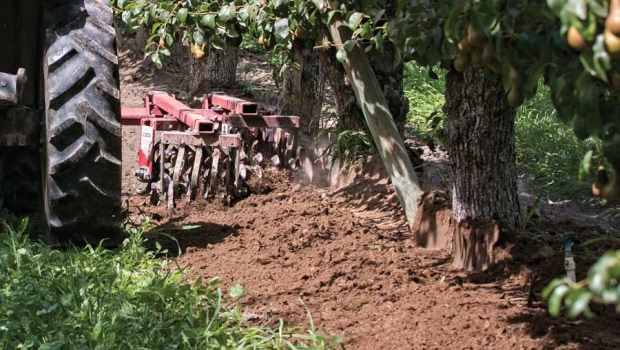
A weeder is pushed through a block of pears, mulching and cultivating the soil around the base of the trees. Maintaining a weed-free buffer helps minimize competition for water and nutrients.(TJ Mullinax/Good Fruit Grower)
When we talk about water in fruit country in the West, we usually mention those things that are key to irrigation: snowpack, reservoir capacity and storage, the elements of supply.
The 2015 season is a stark reminder of why, as drought reduced water availability across the West and forced curtailment of irrigation in some orchards.
But Dr. Lee Kalcsits of Washington State University took a few minutes during the Washington State Tree Fruit Association’s meeting in December in Yakima, Washington, to discuss demand, offering practical approaches to limit or reduce water use in an orchard.
After all, sooner or later, there will be another drought similar to 2015, said Kalcsits, an assistant professor of tree fruit physiology at WSU’s Tree Fruit Research and Extension Center in Wenatchee, Washington.
“They’re going to come along again,” he said.
So, here are Kalcsits’ six tips for reducing water use in an orchard:
—Maintain a weed-free strip. Weeds compete for water and nutrients with tree roots. The shallow root zones of dwarfing rootstocks give those weeds an advantage. Give your trees about 3 to 4 feet of weed-free buffer, which should be plenty for dwarfing rootstock roots.
—Use mulches to hold in moisture and reduce soil temperature, as well as to improve the overall nutritional quality of your ground. Good mulching techniques can reduce a tree’s water demand by 25 percent, earlier studies have shown.
—Mow cover crops. Growing grass between rows is important for keeping down dust and for other practical reasons, but the more leaf area of a cover crop, the more evapotranspiration occurs and the more water it uses. Studies have shown cover crops can consume more than 1 acre-foot of water. Keep it short.
—Water accurately. As much as possible, target irrigation only to the spots where the trees, and only the trees, will use it. That means drip irrigation, something the industry has been shifting toward for many years, Kalcsits said.
—Use an irrigation scheduler. He suggested WSU’s Ag Weather Network, but other companies have designed similar phone apps. “It takes weather data and environmental data, and it tells you how much water it thinks the tree is using,” he said.
—Use soil moisture sensors. There’s a variety of models, but they all measure water and changes in water over time and offer a way to schedule irrigation even more precisely. If you use a set irrigation schedule with no variation, you might irrigate too little or too much at different points in the season. •
– by Ross Courtney






Leave A Comment